Farewells and strategies
Hondas bow out of F1 on a winning note
“It was possibly one of the best strategies that we have ever applied. In the middle of the race we deliberately ran at a pace which, if sustained, would have seen the car run out of fuel by the finish in order to open out a significant advantage once we were in the lead. Gerhard’s tyre stop went well, a credit to the team, and the engineers timed it to perfection. Of course it was a good race to win for Gerhard and an incredible success for the team.”
Ron Dennis speaking. Smiling. Laughing. Rightly savouring victory. It was a good one, this, taken the hard way but on a weekend when McLaren Honda was markedly closer to Williams Renault than it has been all year. The red and white cars were competitive from the outset, and they stayed that way. Either Senna or Berger could have won.
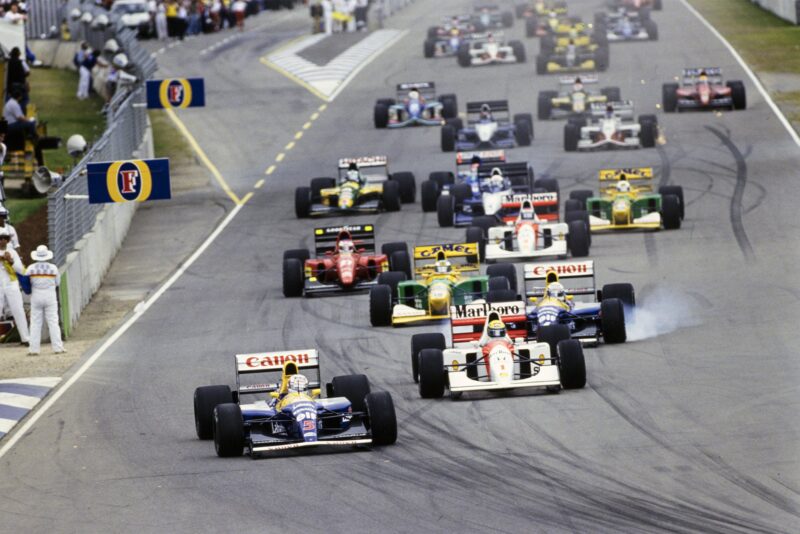
Nigel Mansell leads into turn one
Motorsport Images
The odds, as usual though, tended to be stacked in the favour of the Didcot cars, for Adelaide is a tough circuit, and a long race in terms of the number of hard corners that have to be negotiated. Neither Nigel Mansell nor Patrick Head thought that their active ride would confer as much of an advantage here as it does on most other tracks, but what the FW14Bs really had over the McLaren MP4/7As was a package offering performance with economy. They could run them with reasonable downforce and still get through okay on fuel; McLaren wasn’t so sure. The Honda V12 has always gone to the line with more fuel than the Renault-powered contenders, because the RA122E demands a fair bit more, and Dennis knew only too well that the situation would be marginal if the pace set by Senna in the opening laps, during a fleet and aggressive pursuit of Mansell, was going to be maintained.
In the end, that situation settled itself at the end of lap 19, when the fragile Entente Cordiale between the Englishman and the Brazilian (united in a mutual detestation of Alain Prost) was shattered along with the McLaren’s front suspension. Each, predictably, blamed the other.
That incident didn’t let McLaren off the fuel hook, because Berger was still going hard after Patrese, as the respective team’s number twos were now emulating their partners’ battle for the lead. For much of the season we have become used to the Williamses looking superior, but in Adelaide they had a genuine challenge. Time after time Gerhard would come thrusting down the inside of Patrese at the end of the long Dequetteville Terrace straight, but each time Riccardo blocked him, fairly but decisively. At one stage a hint of desperation crept in, and we began to suspect that this might end in tears, but instead Gerhard just kept on pushing and then tried a novel outside line on lap 20. This time it worked and he nosed ahead, but only for as long as it took him to run wide and for Patrese to nip back down the inside. It was sterling stuff, and it was noticeable just how easily the Austrian could reel the Italian in again. At the end of that lap the gap had gone out from a second to 2.2s as Gerhard gathered himself; two laps later it was back down to 0.6s and as the ambient temperature began to climb again after the race’s overcast start, it stayed the same. It was never more than 1.7s over the next 10 laps, and then came Berger’s crucial tyre stop on lap 35, which elevated Michael Schumacher to second.
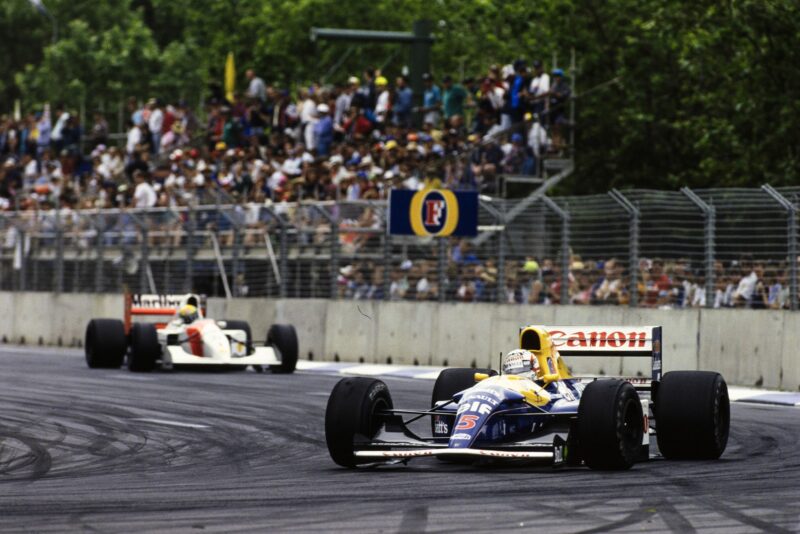
Nigel Mansell leading Ayrton Senna. Both would end the season with retirement
Motorsport Images
The German had always been in the shadows, biding his time, not pushing too hard too soon. He’d made a super start to harry Mansell, Senna and Patrese in the opening laps, with Alesi behind him followed by Berger and Brundle, but he conceded fourth place to Berger without fuss on lap three and thereafter concentrated on keeping their leading quartet in sight without overstressing his machinery. He knew going in that he would be slow on the straight because of the amount of downforce Benetton had to run to generate sufficient grip. It was textbook common-sense, further evidence of a wise head on young shoulders.
Now, with Berger temporarily delayed, he began to snatch at opportunity. The gap to Patrese was just over three seconds on lap 36, but then he pared it to 1.8s, then 1.2s. Around this time Mika Hakkinen was waging war with Aguri Suzuki, cursing a lap four incident when fighting with de Cesaris for eighth place which had spun his Lotus and dropped it way down from ninth to 20th. Now he and the Japanese driver were about to be lapped. Mika had already held up Patrese, but now as Riccardo dealt with the Footwork driver, so Schumacher moved close to his old F3 adversary. Back at Macau in 1990 Michael outsmarted Mika, took the edge off the Finn’s British F3 Championship year; perhaps that was in Mika’s mind as he steadfastly refused to accommodate the Benetton driver. Certainly, the Lotus 107, Series V Ford HB notwithstanding, looked pretty good against the Benetton B192 and its Series VII. And certainly, Mika was racing against Suzuki as hard as Schumacher was racing against Patrese. But the code usually calls for the lapped to give the leaders a break, and this Mika did not do for a couple of laps. By the time he finally conceded, Berger was back with Schumacher, up to speed after his stop and looking threatening. It would have a crucial effect on the outcome.
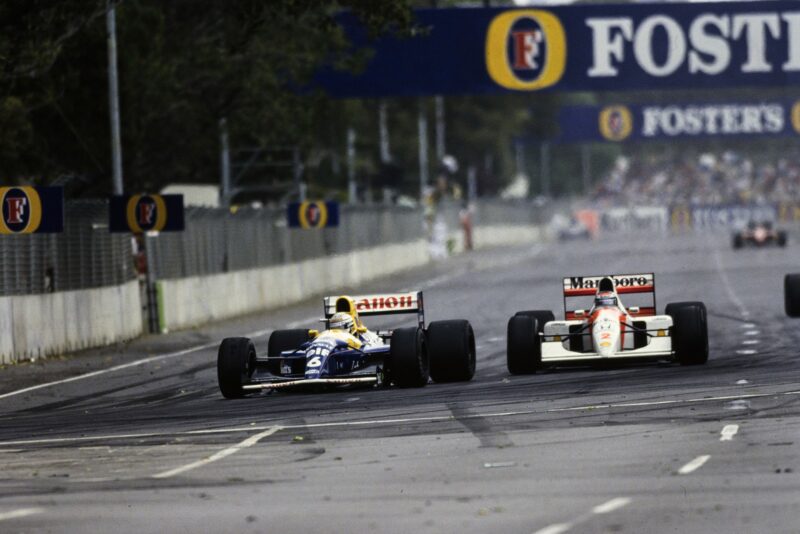
Riccardo Patrese and Gerhard Berger go wheel-to-wheel
Motorsport Images
As Patrese eased out a five-second lead by lap 42, Berger was within tenths of the green and yellow car, and when Michael stopped for tyres on lap 43 the Austrian swept back ahead, thirsting after Riccardo. He had the gap down to 3.8s when Fate stepped in to do the rest. Coming through the right-hander at East Terrace on his 51st lap, Riccardo felt the Williams die. “Everything went dead and the lights all came on. I put my foot on the accelerator, but there was nothing there . . . ” The FW14B stopped almost on the blind racing line, and Riccardo made an undignified exit through the protective debris fencing. Berger was on a home run.
It continued to look that way, even through the laps in the early 50s when a light rain fell out on the back of the circuit, and Gerhard’s 25s lead seemed impregnable. That, however, was when Schumacher really began to fly.
After a plague of locusts had visited itself on the circuit early in the morning, the wind had begun to whip up shortly before the start, spreading leaves and debris on to the track. By this stage Berger had picked up something in a sidepod which partially blocked a radiator and created a degree of overheating. Schumacher, meanwhile, was piling it on, lapping consistently in the 1m 16s as the race moved past the 60th of its 81 laps. He had been kept out by the team personnel because they had worried that fresh tyres might not have too significant an effect on lap times. By the time they realised they were desirable his stop set him behind many backmarkers, and he was feeling really aggressive. All he could now do was push as hard as he could, and this he did to stunning effect. From 16.5s on lap 65 the gap had shrunk to 11.5s by 70, 8.4s by 75; behind him by then lay a fresh lap record of 1m 16.078s, a time that would have put him sixth on the grid!
“I knew that Gerhard would probably be able to respond and stay ahead,” he admitted afterwards, “but it was a good race. Very enjoyable!” It was all of that. It provided a gripping and fitting climax to the year. Going into the last lap he and Berger were 5.2s apart, and as Gerhard backed off as much as he dared his precise advantage was 0.741s as they crossed the line. For Berger it was his most satisfying victory of his spell with McLaren, and one he had earned. For Schumacher, yet further evidence of a glittering future.
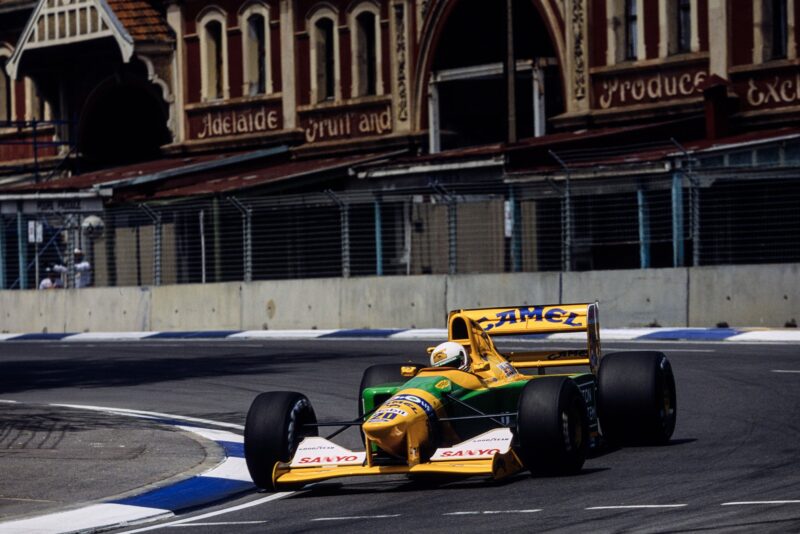
Martin Brundle on his way to another third place finish
Motorsport Images
Behind them, Brundle had swiftly moved into Michael’s wake once he’d disposed of Alesi on lap two, but he discovered early that Benetton had overcompensated for his practice understeer and was consigned to coping with oversteer thereafter. Denied the chance to attack he settled for a sensible run and yet again made the podium. For Benetton, too, with its second and third places, came the satisfaction of emulating Lotus and BRM’s feat from 1963 of finishing in the points in every championship race. A fine achievement and further indication of the seriousness of its challenge.
Betting men probably wouldn’t have put money on any of the other points scorers, but the irrepressible Alesi again brought his slow Ferrari home, at least enjoying its reliability if not its performance, while Boutsen did very well to recover from his lowly grid position to fight past Gugelmin, Suzuki, Morbidelli and Modena. He picked up de Cesaris’ sixth place as the Italian’s Tyrrell caught fire when an injector detached itself on lap 30, and Patrese’s demise brought him his first points of the season. For Modena Australia was some sort of vindication, as indeed it was for Jordan and Yamaha. In a race in which nobody expected the thirsty V12 to last, the Italian began with a 1000rpm cut, leaned off the mixture after 20 laps, and survived heartstopping moments when the fuel pressure fluctuated during the last three laps. It all kept going, however, and he finally secured the final point. If only he had tried to look like a racer all season.
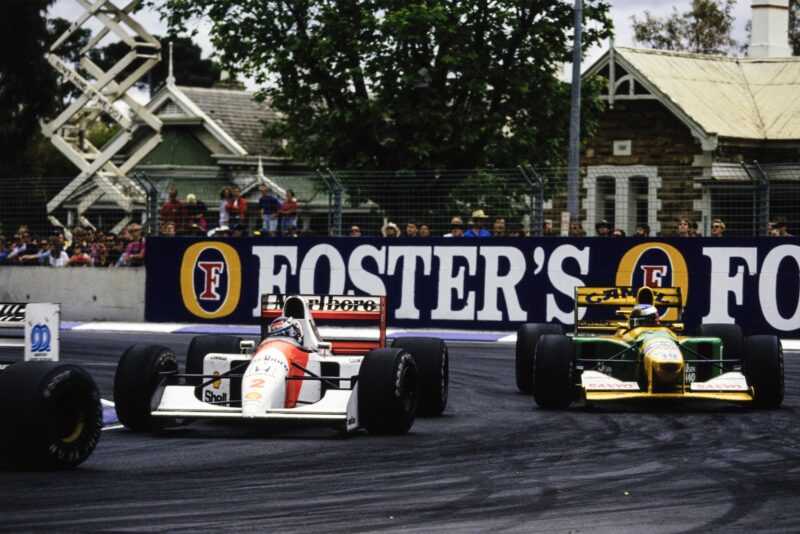
Berger and Schumacher fight for the lead
Motorsport Images
Hakkinen was seventh, experiencing a few downchange problems in the latter half, but team-mate Herbert was again a victim when Grouillard jumped the start, spun and collected Martini, and Johnny caught their debris. After a three-lap stop for a new nose and track rod, he resumed and lapped quicker than Hakkinen (eighth fastest overall) on his way to a dispiriting 13th. For Lotus, its newfound reliability was scant consolation in the face of such ill fortune. The Australian GP thus brought an era to an end. Senna and Berger said farewell to McLaren, Brundle to Benetton and Honda to F1 itself, but nothing summed up the sport’s current sad plight than the rumours that surrounded Mansell all weekend. This, of course, was supposed to be his last Grand Prix, but with Bernie Ecclestone absent, apparently in the States trying to buy out the Englishman’s Newman Haas lndycar contract, who could say that for certain? Not even the man himself really knows precisely what his future holds.
Australian Grand Prix, Adelaide, November 8
81 laps of 2.349-mile (3.780 km) circuit (190.251 miles;306.208 km)
1. Gerhard Berger – McLaren MP4/7A-Honda V12 – 1h 46m 54.786s
2. Michael Schumacher – Benetton B192-Ford-HB V8 – 1h 46m 52.527s
3. Martin Brundle – Benetton B192-Ford-HB V8 – 1h 47m 48.492s
4. Jean Alesi – Ferrari F92AT-Ferrari V12 – 80 laps
5. Thierry Boutsen – Ligier JS37-Renault V10 – 80 laps
6. Stefano Modena – Jordan 192-Yamaha V12 – 80 laps
